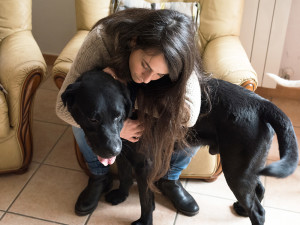Understanding the Signs and Risks of Canine Osteosarcoma
Osteosarcoma in dogs can strike various parts of their body, from the limbs to the jawbone. Don't delay, learn about the causes and impact of osteosarcoma on your pup.

Share Article
No one wants to have the words “my dog” and “osteosarcoma” in the same sentence together. Unfortunately, ignoring a problem has never made it go away, and nothing in this world will teach you that more directly than a dog. Being a pet parent is a constant learning experience, even when it’s time to learn about bone cancer in dogs. The more you know, the better your chance of protecting your good boy or girl and getting them a diagnosis and treatment plan as soon as possible.
Osteosarcoma is a bone tumor, and it is one of the five most frequently diagnosed types of cancer in dogs. Research has found that there may be a connection between these tumors and a dog’s weight and height, so you can have a better idea of how susceptible your own pet is to these potential tumors. Learn more below:
What is osteosarcoma?
Osteosarcoma in dogs is the most common canine bone cancer. It accounts for 85 percent of all skeletal tumors, or roughly 25,000 cases annually in the U.S. It can be very aggressive and is most often seen in the forelimb above the dog’s “wrist,” or in the tibia or fibula of the hindlimb, as well as in the femur. Osteosarcoma can also occur in other bones and is sometimes seen in the vertebrae and pelvis.
In a report presented by a pet insurance company at the 2016 AVMA conference, they wrote, “Disease prevalence starts to climb in late middle age, peaking from age eight to 11, after which prevalence declines in step with the typical lifespan for large and extra-large dogs. Gender does not appear a significant risk, although male dogs are slightly more affected than females.”

That means if you have a large or extra large dog (you choose), that dog is most vulnerable to osteosarcoma in their middle age. If they get through that without any osteosarcoma, they’re likely to live as long as any other dog of their breed without that type of cancer.
Are certain breeds predisposed to osteosarcoma?
Dogs who are selectively bred for desired traits may end up with a higher risk of genetic predisposition to certain diseases and cancers, unfortunately. Osteosarcoma has been studied a lot, and it's the large or giant breed dogs who are most commonly affected. That means the Irish Wolfhound, Greyhound, Akbash, St. Bernard, Leonberger, and Rottweiler.
Signs and symptoms of osteosarcoma.
Watch how your dog walks — if there’s no obvious reason why they’re suddenly struggling with walking or favoring a leg, that’s a big sign. Swelling and pain are common indicators of osteosarcoma, and as pain increases, it might affect your dog’s mood, of course. If they start seeming irritable and less willing or able to move around or exercise, they should be checked out.
Problems walking
Favoring one leg
Swelling
Pain
Irritability
Some pet parents discover the tumors because osteosarcoma-weakened bones are prone to fractures, but you don’t want it to get that far. By the time it’s diagnosed via some other injury, it may have metastasized to the lungs, which makes treatment more challenging.
How is osteosarcoma diagnosed?
To diagnose a malignant bone tumor, X-rays are the first test of choice. On an X-ray, osteosarcoma will give the affected bone the appearance of being moth-eaten — or lytic, in vet-speak — due to the loss of normal bone tissue. There are other far less common conditions that can also cause this appearance, so to reach a definitive diagnosis, the next step is usually a fine-needle aspirate or a biopsy, meaning a sample taken from the tumor site. Both are done while the dog is sedated.
If osteosarcoma is confirmed, the vet will stage the cancer to determine how advanced it is. Bloodwork, urinalysis, lung X-rays, and an abdominal ultrasound are usually involved. If enlarged lymph nodes are found, additional biopsies may be needed.
How is osteosarcoma treated?
The treatment can be extreme because osteosarcoma is fast-moving and highly likely to metastasize.
Amputation
It’s generally the recommended treatment for the limb affected by the bone tumor to be amputated and then for the dog to receive a round of chemotherapy. Amputation is not always a viable choice depending on the tumor’s location.
Radiotherapy
According to “Osteosarcoma in Dogs,” a 2002 paper written by Wendy Brooks, DVM, DABVP, and revised in 2019, “For most patients, there is one tumor on a leg and no visible tumor spread in the lungs. These are the patients with the best potential results, and they are good candidates for amputation. Patients with a lot of arthritis in the other legs or with tumor spread evident in the chest already are probably not candidates for amputation, and it may be more appropriate to keep the leg and simply relieve the pain with radiotherapy.”
ELIAS cancer immunotherapy (ECI)
A vet should focus on relieving the dog’s pain and doing as much as possible to stop or slow down cancer’s spread. They may have other suggestions if amputation is not the best choice for the patient.
For example, ELIAS cancer immunotherapy (ECI), a recently developed experimental treatment approach, was used in a study initiated in 2017 by researchers at the University of Missouri College of Veterinary Medicine. The goal of this first-of-its-kind study was to develop a “patient-specific, precision-medicine treatment” for bone cancer in dogs. Ultimately, they were able to create a personalized vaccine from the dog’s osteosarcoma that — unlike chemotherapy — targeted cancer-specific cells and left normal cells untouched.
In this study, the entire treatment protocol was completed in eight weeks rather than the many months required for conventional chemotherapy. According to the reportopens in new tab in the Journal of Veterinary Internal Medicine, for 14 dogs treated with ECI, the median survival was 415 days, and five dogs survived longer than 730 days. All of these dogs had surgical limb amputation prior to the immunotherapy, but none received chemotherapy.
Research like this is part of something called comparative medicine. Using resources created by evolving technology, scientists look for similarities and differences in canine and human cancers that will lead to better ways to prevent, diagnose and treat the disease in both. For osteosarcoma, that involved studying its genetic profile in both species. When they looked, researchers found the profiles to be indistinguishable. We are just like our pets.
What causes osteosarcoma?
Research out of the University of Wisconsin-Madison School of Veterinary Medicine may have identifiedopens in new tab the biological mechanism that gives some cancer cells the ability to form tumors in dogs. The scientists identified several hundred genes that expressed differently between the tumor-forming and nontumor-forming cell lines.
One protein in particular, called frizzled-6, was present at levels eight times higher in cells that formed tumors. Proteins and RNA, like frizzled-6, are responsible for many vital cellular functions, like receiving information and activating pathways that regulate growth. When these pathways go awry, they may contribute to the development of tumors.
Though a preliminary association has been made, it’s not clear what role frizzled-6 plays. It’s possible that the frizzled-6 expression may be inhibiting a signaling pathway that contributes to the formation of tumor-initiating cells. If they can prove that frizzled-6 is behind the tumor-forming cells, the protein may provide oncologists with another target for therapy which would improve outcomes for cancer patients, both canine and human.
Resource:
University of Wisconsin-Madison - Possible biological trigger for canine bone cancer foundopens in new tab
Susan Tasaki
Freelance writer Susan Tasaki lives in the San Francisco Bay Area with her Husky, who wishes they both got out more.
Related articles
![A German Shepherd sitting on a bridge outside.]()
Understanding Hemangiosarcoma in Dogs: Blood Vessel Cancer in Dogs
A common canine cancer, described
![Young Man With Retriever Puppy]()
When Should You Spay or Neuter Your Dog?
The research is confusing—here are some guidelines.
![A woman hugging a black lab in her arms.]()
Everything to Know About Canine Mast Cell Tumors to Keep From Freaking Out
The sooner you catch this common cancer, the better your chances are for giving your dog many more happy, healthy years.
![A vet holding medicine near a dogs face]()
How to Find a Veterinary Specialist
Just like your doctor would refer to you a specialist for expert care for a complicated issue, your vet may do the same for your dog.






